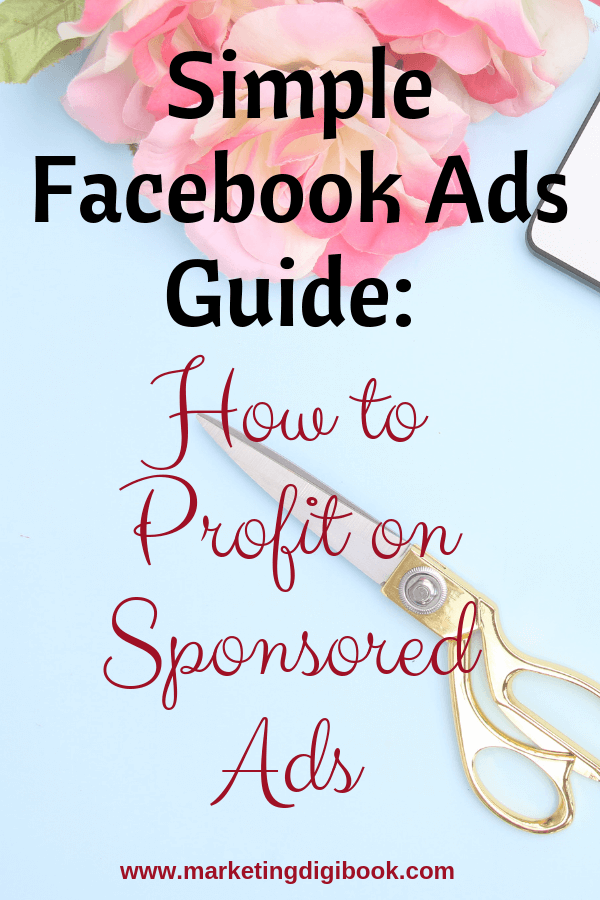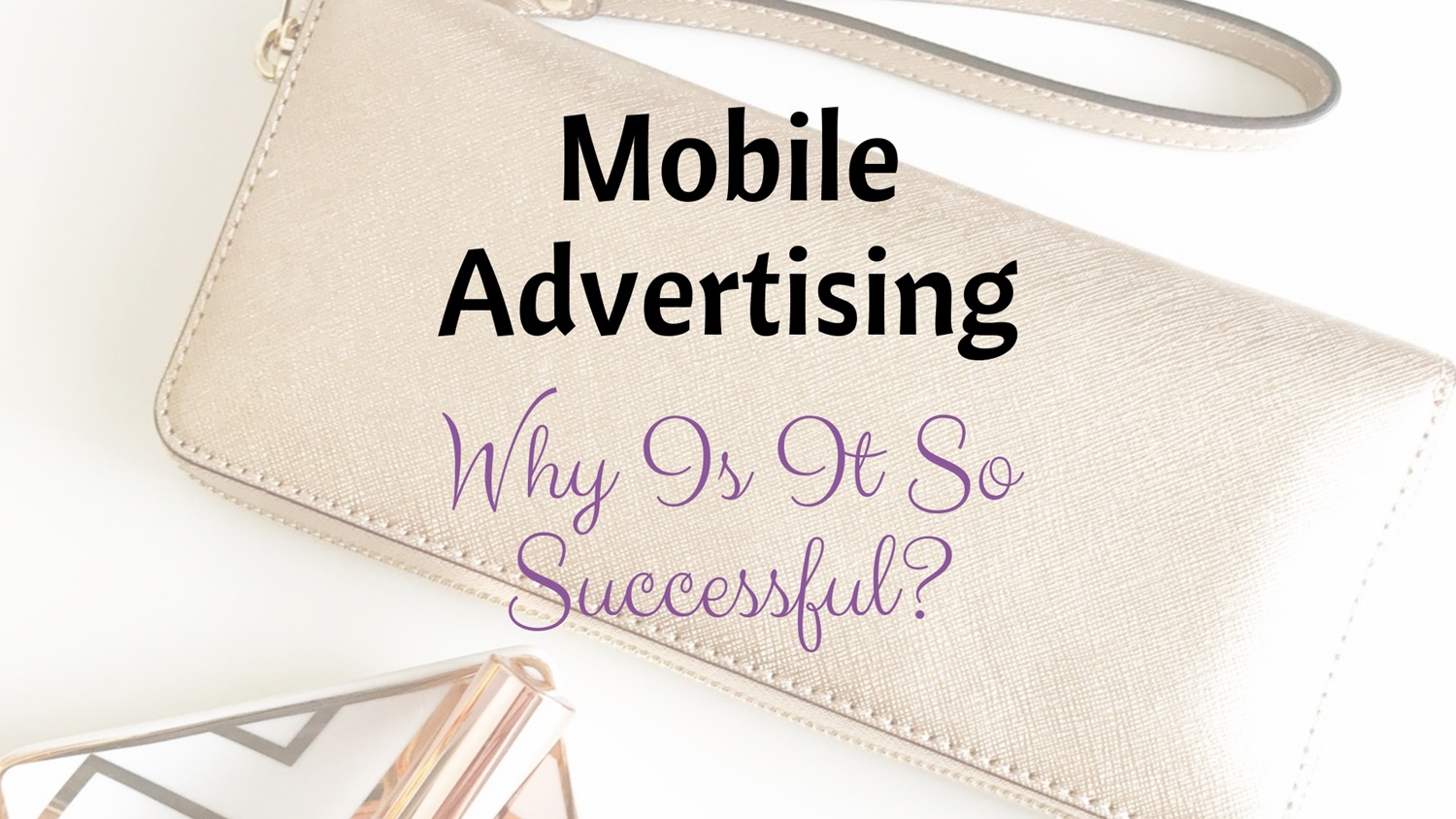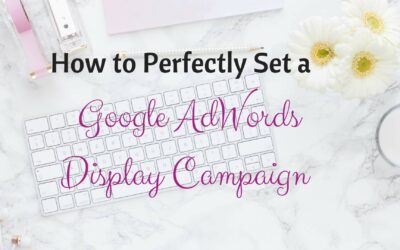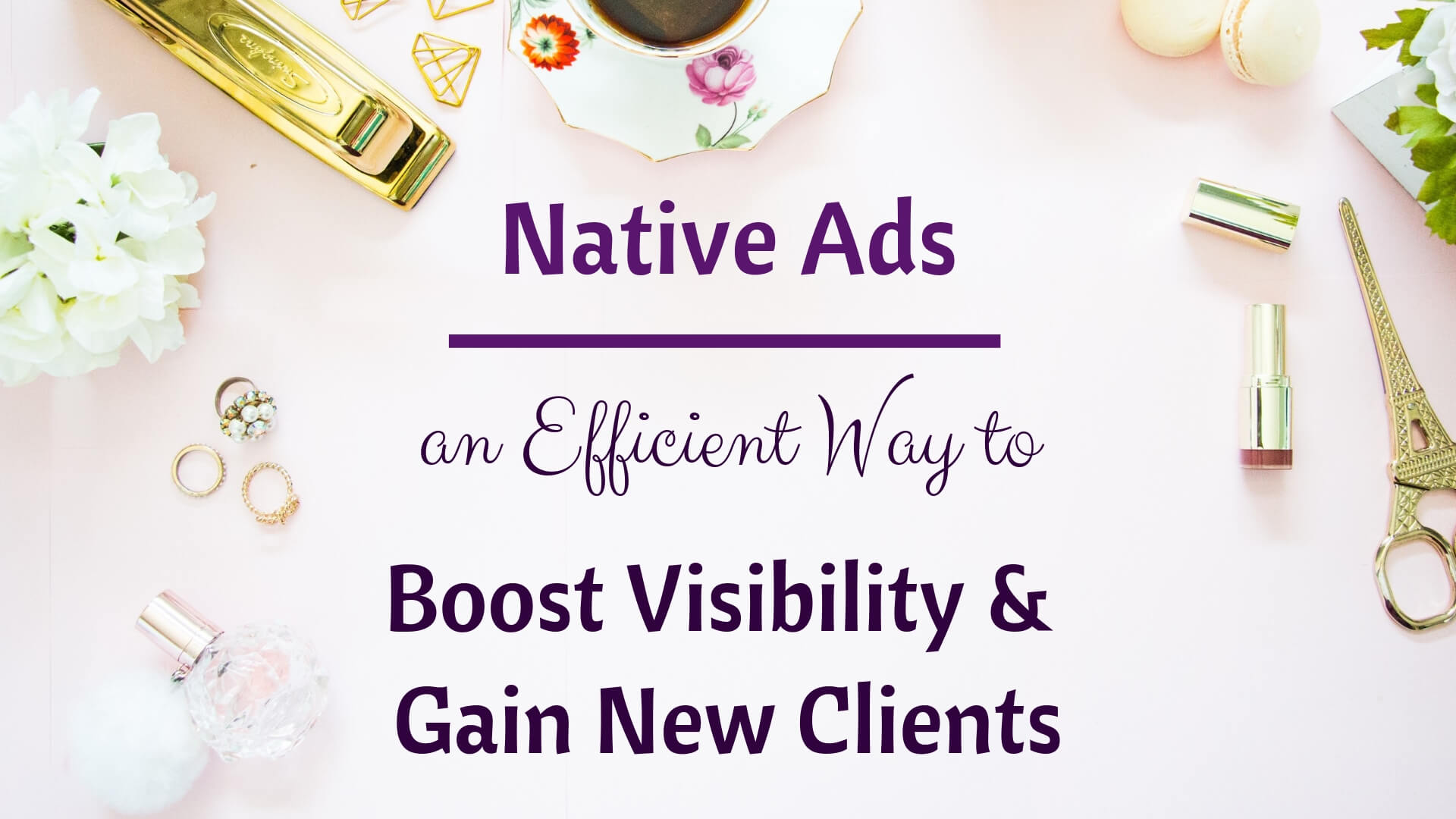Are you new to Facebook advertising and searching for simple Facebook ads for the dummies guide? Then this article will give you all the important expert advice that you need.
There is literally a myriad of ad choices today, both free and paid and according to Adweek, tables turned in 2017 when digital advertising exceeded TV advertising. With the huge amount of content being thrown around each minute, consumers have become fatigued and their attention span has become shorter than ever, just about 8 seconds.
But this can change if you can better understand your consumer’s purchase behavior and motivation by leveraging the data shared by tech research and insights discovered lately and using this to give your consumers exactly what they need when they need it and where they need it.
Disclosure: This article may contain affiliate or sponsored links. If you decide to make a purchase using one of these links, I’ll make a small commission without impacting the price that you will pay. I recommend just services or products I find useful and that I have tested or currently use
Let’s Make Your SEO & Content Work Better for Your Business
Advertising is all about giving your consumers an enjoyable experience that will convert into a purchase. And this is why Facebook ads remain the best overall ad channel for you to use.
Which would be a simple definition of Facebook advertising: the action of paying to place advertising/ promotions in Facebook feeds targeting a specific audience.
Here are a few reasons why Facebook ads for dummies is your best choice for the moment and in the near future:
Why You Should Use Facebook Advertising
World Wide Customer Reach
With over 2 billion active monthly users, Facebook remains the juggernaut in digital marketing today and possibly in the years to come. This is a huge audience with great diversity.
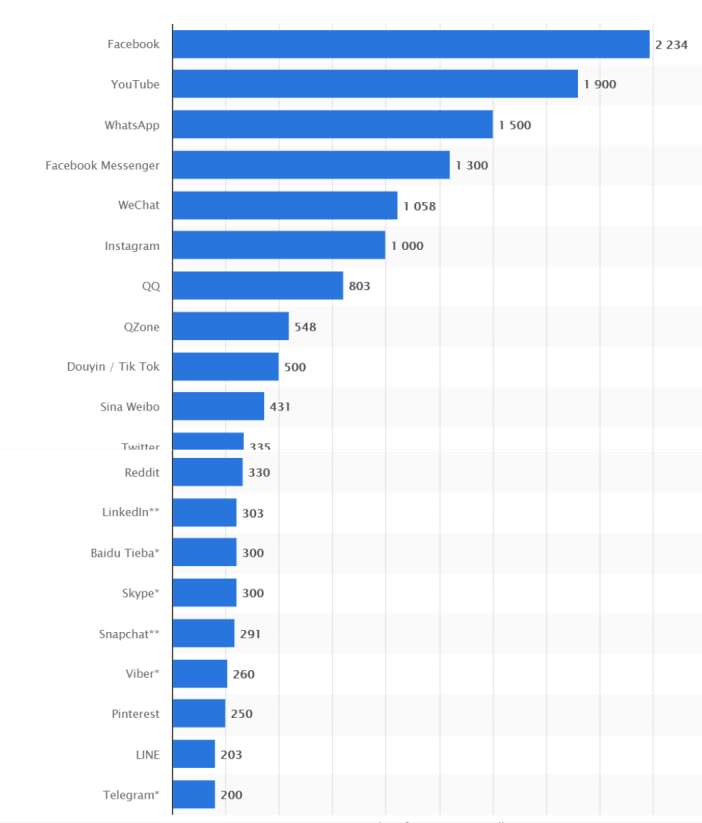
Social media channels ranked by the number of active users by the end of 2018
Taking into consideration that the ever-changing algorithm that Facebook uses transforms the organic connection with fans into a struggle, Facebook ads are the remaining substitute.
2. Simple to use
You can create ads fast and easily from your Facebook page. You can use either the “Boost Post” or “Promote” button with a few clicks. But everything highly depends on your objectives.
3. Split testing
Facebook allows you to test your ads on various bespoke audiences and core elements of an ad included in one campaign. What this means is that you get valuable data on your target demographic and this way you create content that’s relevant to them and the efficiency of your ads improves.
4. Lead generation
Facebook lead ads make it simple for your potential customer to give you information through the lead ad form that appears on their screen irrespective of the gadget they’re using. Here customers can request more information on your products or services directly. This engagement with the customer is something that you’re going to need.
5. Conversion measurement
Facebook provides metrics, insights, and other tools that you can use to measure your success and the return on ad investment for your campaigns. This way you can understand the effectiveness of your ads and the actions that drive success.
6. Your ads are tailored to your specific goal
Facebook provides an array of advertising objectives; this means that you’re able to choose the options that best suit your brand’s goal.
7. Cost effective
You can spend up to a minimum thread placed between $1 to $5 a day based on your budget and ads campaign, in order to manage your Facebook advertising costs. And as you proceed you can adjust, pause or stop ads as finances change in your business. These features make Facebook ad pricing adjustable and cost-effective.
Facebook ads can be very cost-effective if you approach them the right way and you know what you are doing. And the reverse of the medal is also true, you can lose lots of money if you approach them in an amateurish way or treat ads superficially.
8. Targeting capabilities
You can target your audience by location, gender, interests, age, demographics, or even purchase history. This means you can engage your target audience with a campaign that’s tailored just for them.
This list is not exhaustive, Facebook’s ads advantages are so much more and keep getting better day passing.
Here are some examples of Facebook ads and Facebook video ads:
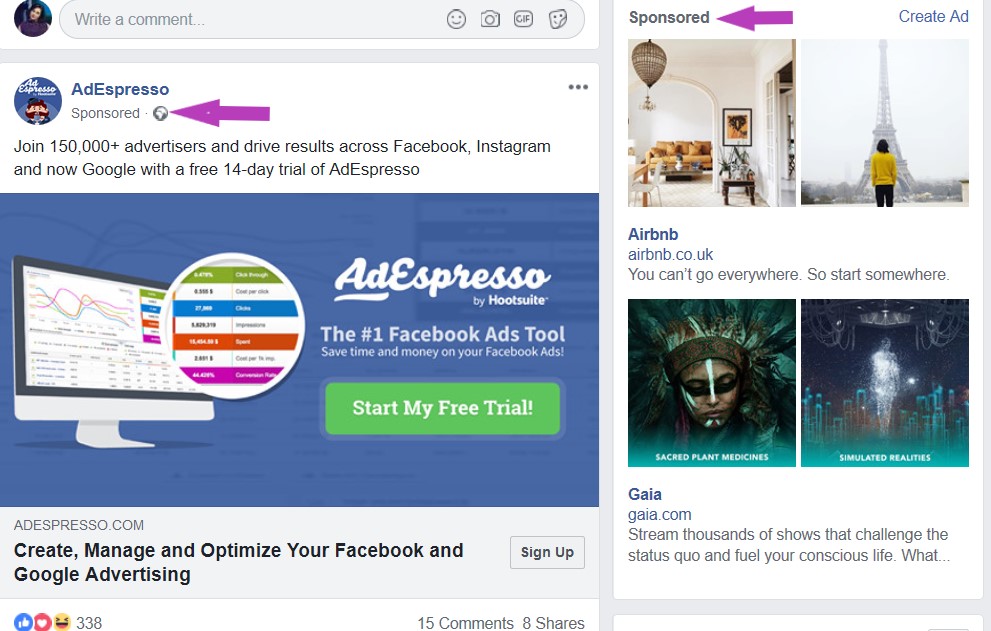
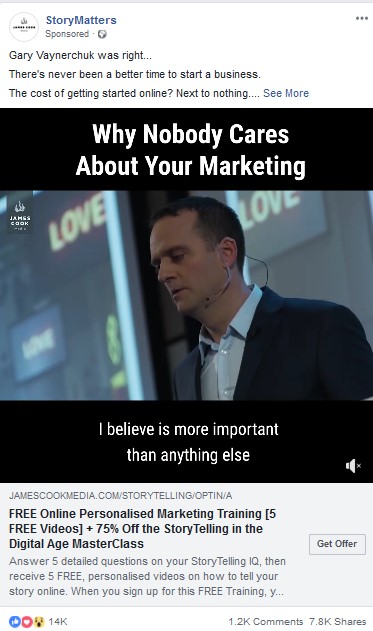
Taking into consideration that advertising budgets are continuously increasing, there should be a solid reason behind this.
If properly managed Facebook ads offer small businesses a relevant competitive edge. Here is an impressive Facebook ads example that illustrates the success you may reach: an eCommerce company Barbell Apparel betted on Facebook ads to surpass their product lunch goal 49 times.
If still in doubt that Facebook ads can be successful, check in the Facebook ads success stories database.
So, with this knowledge in mind, how then do you create a winning Facebook ads campaign?
Ouch, tough question!
How to Create Facebook Ads Step-by-Step and Ads That Convert
Facebook advertising comes in two categories. There is paid advertising and organic advertising. They’re both very effective if done well, except that with the free advertising method, it will be required much more time to deliver consistent results. The paid method on the other hand means you get a swift and easier start but at a cost.
Some of the options offered by Facebook on the paid ad method include:
- Boosting brand awareness
- Boosting videos
- Boosting app installs
- Boosting page likes
- Boosting page visibility
- Boosting engagement
Free Facebook ads give you these options to promote your ad:
- Sharing content
- Joining groups to market your brand
- Manually inviting people to your page
- Engaging people in discussions
As you can see, free means more work. Notwithstanding all these, here are the steps to follow for either method you pick, to help you meet those targets:
Facebook ads for dummies: Identify your objective
Before starting your ads campaign, you must have an objective that will help you become visible to your prospects and that will make them think about your product. This objective must be backed up by a strategy. Ask yourself the following questions:
- What’s your specific product?
- Who are you targeting?
- How is the product used?
- What is the goal of the campaign?
- Which are the pain points and objectives that your product solves?
- What’s your budget?
The bottom line here is that your ads should generate meaning and purpose to your target audience; they should add value and at the same time nurture your credibility as it opens your relationship with the future consumer.
Your ad objective could be:
- Store visits
- Conversions
- Traffic
- Brand awareness
- Engagement
- Lead generation
Facebook ads for dummies: Develop your strategy
If this is your first attempt at this, you may feel a little overwhelmed on how to balance the Facebook posts, videos, infographics, and even how to keep creating new relevant content. But here are a few things to help you through:
- Understand the customer journey by knowing the best way to reach them, and then include emotion and expectation to make your content relevant.
- Know your placement, will it be a Facebook page? Instagram? Audience network? (as explained below)
- Make sure your ad communicates your brand’s core values.
- Be ready to adapt to the ever-changing data, you’ll be more effective with time.
- Focus on your ideal client and let that ad speak to their goals, challenges, and opportunities. b. Choose the placement of your ads
Placements are simply where you want your ad shown. It is the place where your target audience spends their time the most. You can allow Facebook to show your ads where they‘re likely to perform best.
Depending on your goals, your ads can appear on:
Facebook – Feeds, Instant articles, In-stream Video, or Marketplace.
Instagram – Feeds or stories.
Audience network – Banner, In-stream video, rewarded video,
Messenger – Inbox and sponsored messages.
The good news here is that your ad can run in all the above options.
Facebook ads for Dummies: Have a budget
Are you wondering how to allocate a budget, how much to what? Or how to choose your budget scheduling in your Facebook ads manager?
Conversion is always going to differ, so testing work is absolutely necessary. Here are experts’ recommendations during the test period:
- Let the ad run for 4-7 days to give Facebook the optimum time to optimize.
- It’s ok to spend $5 to $10 per ad but if your budget can allow for more, the better and quicker the results.
Once you get into the budget and schedule part of the Ad Set, you have the daily option and the lifetime option. The daily budget focuses on spending a bit each day while the lifetime budget is for the entire campaign period and can end up using more money. For you as a Facebook ads beginner, the daily budget is advisable.
The benefit of testing your ads will help you with the Facebook ads budgeting phase, as you’ll find out which ad performed the best, and then you can scale it up and pivot on it.
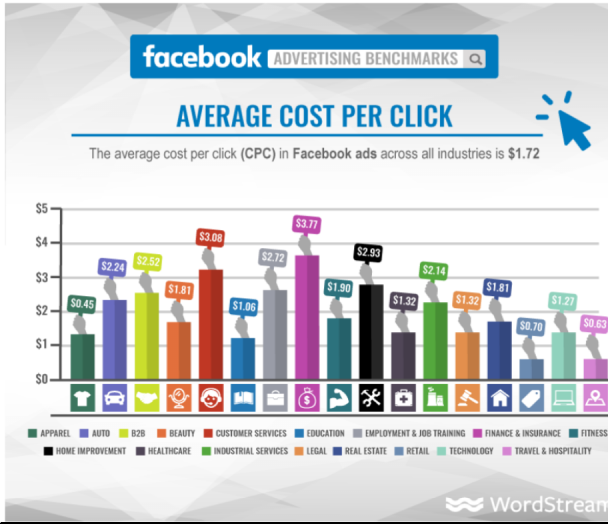
Source: WordStream
d. Choose your Facebook ads format
Facebook offers several ad formats you can pick from. These are the types of Facebook ads:
i. Instant experience
ii. Image
iii. Collection
iv. Video
v. Carousel (lets you show several pictures or videos)
vi. Slideshow
vii. Lead generation ads
viii. Offers
ix. Post engagement
x. Event responses
xi. Page likes
Each ad type offers unique advantages and depends on your ad’s goal or objective. That said, Video ads and Carousel are known to have the highest engagement.
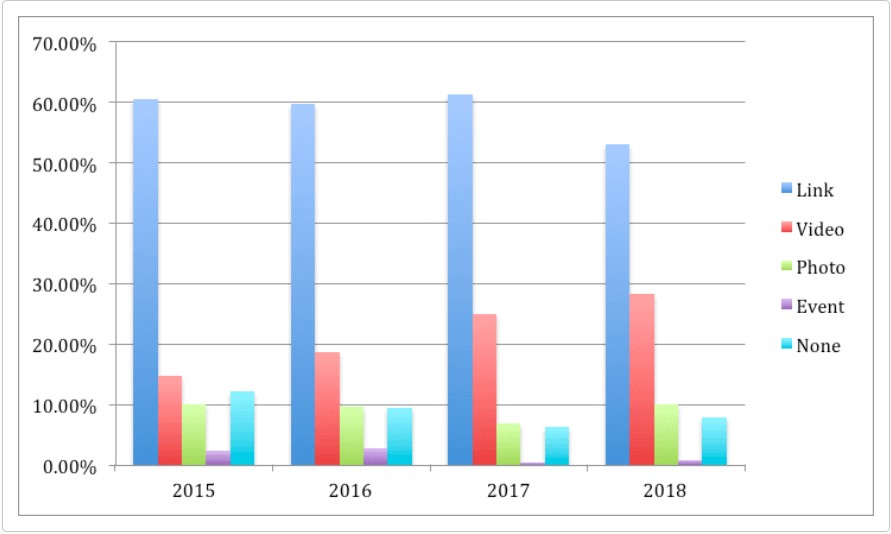
The next stage of this Facebook ads for dummies tutorial is to create the ad itself.
Now, let’s create that first winning Facebook ad.
Consider these key strategic steps:
a. Define Your Sales Funnel
The funnel is a set of steps a user is guided through before they reach the conversion level. So, then it’s obvious that your Facebook ads success narrows down to having a high-converting funnel. But how do you build a high-converting funnel?
- First, you attract customers with valuable content that solves their problems.
- Then encourage action by building a simple emotional and compelling landing page that will quickly create a connection.
- After that create a content plan that will resonate with your audience by knowing precisely what they will need or want at each conversion stage.
b. Proof of concept
This simply means that by the time you’re creating this Facebook ad, you’re positive that people actually need or want what you’re selling.
c. Install the Facebook Pixel
This is a small piece of code that acts as an analytical tool, allowing you to measure the effectiveness of your ad by understanding the actions people take on your website. Facebook pixel is vital for creating lookalike audiences. You should therefore set it up first to be able to optimize your ads to the right people.
d. Write a killer ad
The best approach here is to write your ad from up to 5 different angles that will resonate with your target audience.
e. Lookalike audience
The minute you get a good amount of conversions, then it’s time to start building lookalike audiences. Targeting people who are similar to your current customers always works.
Having worked on the above key points before creating your ad, has proven to propel Facebook ads upward leading to faster success.
Now that you have all the basic winning tips for creating a great Facebook ad, the next thing you need to know is how to manage them.
Facebook Ads for Dummies: How to Manage Your Ads
You have created a brilliant ads campaign, and it’s up and running; now you need to measure its effectiveness, influence, and overall quality.
Facebook has made this easier by incorporating management tools that will help you see what’s working and what’s not. These tools also help you experiment with various images, titles, and texts to see which gets the best response.
These tools are:
Facebook Ads Manager
The ad manager helps you to:
- Customize your graphs and tables to see the metrics that present valuable information for you.
- Duplicate your ads, ads set, or ads campaign.
- Edit your ads setting e.g. targeting and budget all from one place
- Follow up on your metrics in one shot.
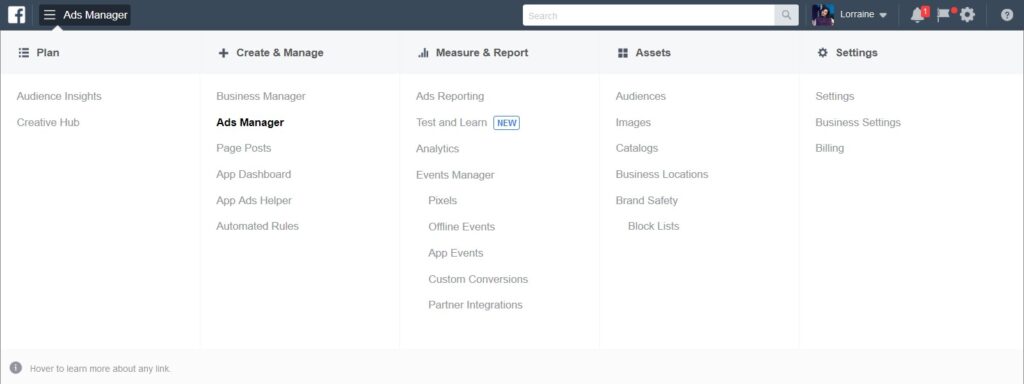
Business Manager
This one enables you to manage all your advertising accounts, pages, apps, and permissions in one place. Through this tool, you can:
- Create and manage separate ads accounts
- Get an overview of your ads impressions
Here is a simple guide on how to set up your Facebook business manager.
So, to recap the benefits of Facebook ads management tools here is a tutorial with a few tips that will come in handy and give you an added advantage for your ads:
a. Learn to keep your audience interested in your content by keeping the frequency of your post relevant. Work with seasonality, high demand, or days such as Black Friday. Along the way, you’ll learn the times that get the most response and stick to them.
b. Create an actual Facebook business page for your brand; do not use a personal account. Why? Because you will miss out on all content creation tools, promotional opportunities, and insights that come with the business page.
c. Make the most of Facebook’s targeting tools such as the bull’s eye button that you can use to set metrics for your preferred audience.
d. Make use of the call to action buttons such as the “watch video”, “sign up” etc. These buttons help you improve traffic to your page, or website or just get a good serving of eyeballs on your Facebook page.
e. Use a recognizable profile picture so that your consumers will easily remember your brand. Be it a company logo or your personal headshot of you personally as a brand, let the image you use be your very first voice.
f. Still on images, let your cover photo also be captivating in a way that catches your audience’s attention. Quality is everything.
g. Use videos. The most shared content on social media today is visual content. This could be, at least partly the reason why Facebook added the “watch now” button. So, make it fun, and informative and allow your audience to get a great experience.
h. Keep an eye on the response on your page and interact with your audience.
i. Promote your page to build your follower base and improve traffic.
When this is all done, now you enter the next phase of finding out whether all the work you put down will bear any fruit.
Facebook Ads for Dummies: How to Measure the Success of Your Facebook Ads Campaign?
Even the best strategy can be a waste of time unless you can prove that it achieved its goal. It is important to know what worked for your brand so that you can improve on it and gain even more. Measuring the effectiveness of your Facebook ads means going a little deeper than the metrics into intangible data, like branding awareness and popularity.
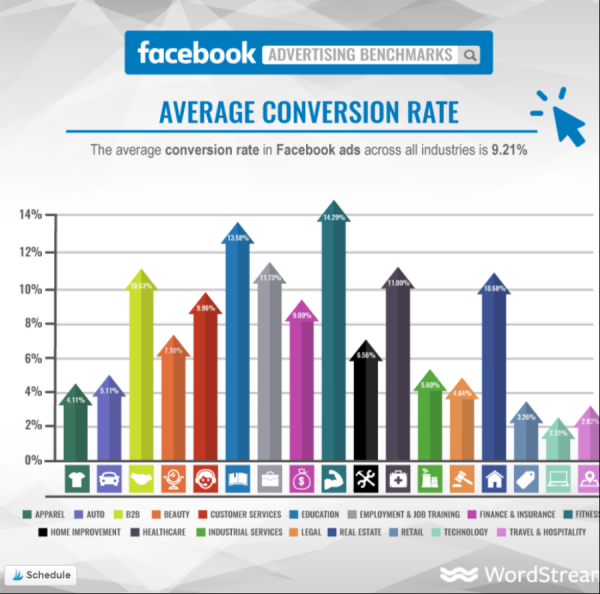
Source: WordStream
Important factors you may want to consider before digging deeper are:
i. Remind yourself of your goal
The only way to determine the success or effectiveness of your Facebook ads is if you compare your initial goal, with what you were trying to achieve in the first place. A goal helps you create a unique formula to measure your success.
ii. No formula fits all
Your formula as indicated above is determined by your goal therefore needs to be unique. Using the Facebook ads report, you have 45 metrics to track. These variables are numerous, so you need to evaluate the ones that make your ads successful and the ones that are relevant to your goal.
Now, with these two key points in mind, let’s look at some of the most effective metrics you can use.
- Conversions
This means different things for different business folks but generally, it refers to whether the audience took the desired action e.g. product to cart or app downloads.
- Reach
This means your brand is viewed and recognized by more people. How many people did your ad reach and what was the percentage of your target?
- Frequency
How many times was your ad seen by the same audience?
- Return On Investment
Whether your brand is new or not, ROI is an important if not the most important metric. That said, don’t get discouraged if the ROI is low when you’re just starting. At this stage brand awareness that drives engagement is equally important. It may take you a little more time to nurture the users’ interest before they make a purchase.
- Impressions
This is the number of times your ad was shown.
Facebook Ads for Dummies: Supplementary Tips to Improve Your Facebook Ads Results
- Take into consideration that Facebook ads are to be approached differently than Google ads or YouTube ads for example, as ads on Facebook are integrated naturally into the flows without impacting the user experience. Also, Facebook users are not looking to buy at that very moment, ads need to capture their attention and rise interest.
Most often Facebook ads fail because of this simple reason: if you just throw up some random ad to a “cold” audience, not familiar with your brand and product, you cannot expect relevant results.
- Best Facebook ads are visually appealing, relevant for their target audience, and include a value proposition and a clear call to action.
- Build different ad campaigns for the different stages of the sales funnel: for awareness, decision, and conversion. And custom audiences play a great role here.
- When you are just starting with ads, no matter the channel, start small and expand later in the function of the situation and goals.
- Never pay for impressions, you want to pay for clicks and conversions.
- The right balance in the ad composition between length, words, and tone are decisive if the viewers decide to move further by clicking on your ad.
- The perfect ad is a combination of a clear, relevant, five-word headline matched with a 20 words ad text that is concise and catchy (Adespresso research finding).
- Link descriptions were shorter in 2018, 13 words, and the top 5 CTAs were “Learn More”, “None”, “Shop Now”, “Sign Up”, “Book Travel” among the selection of over 30 CTAs that Facebook provides. (Adespresso research findings)
- Respect Facebook specs, and use less overlay text to have better results from ads.
- Video ads are more and more popular, when creating Facebook video ads consider inserting the most important information in the first 5-10 seconds, using the primary colors (red, yellow, blue), and taking advantage of scrolling text.
- First focus on small changes that will bring the largest wins.
- Conserve what works for you in terms of ads and continuously test to improve your results. Test small variations and only one at a time.
- Ad fatigue will interfere after a certain time, ads performance will decline after a few weeks or sometimes days.
- Don’t stop the campaigns too early, before they touch their potential, give them at least a week to evolve.
- Run the best-performing ads set until it starts declining, which might be a week, most often around 5 days.
- Start to expand on your ads – increasing budgets and reach, only when your ads are generating positive ROI.
- Experiment with audience targeting.
- Custom audiences are the common elements for high-performing Facebook ad campaigns.
- Do your best to increase the Relevance Score, as that translates into higher click-through rates and lower costs.
- Facebook ads are not unfortunately rocket science, you have to cater your own way and find out what works for your business. Test everything, track and optimize continuously your ads performance
- To improve direct sales via Facebook, target persons that already considered your products and visited your site.
- It’s possible with Facebook to track offline conversions too.
Here’s something to note, Facebook marketing can now alert you if your ad fails to deliver and consequentially offer more details on why it failed. The new “ad run status” feature will indicate if something is not right with the ad and will list the error codes that affected its running. This troubleshooting by Facebook allows you stay on top.
Results indeed come first. Determining the proper metrics to evaluate your campaign allows you to optimize your Facebook ads strategy to improve your outcome.
Finally
If your business is new to Facebook advertising, remember that your first goal isn’t to just sell, but to promote your content that’s related to your target audience in entertaining, informative and unique ways. Your primary goal should be to get click-through and traffic to your website. Following your landing page should be properly optimized to avoid your entire effort going down the drain.
But Facebook is a great platform for businesses of all sizes and it’s a rich territory for all your marketing plans that can support your business expansion if properly used, and Facebook ads is particularly such an example.
